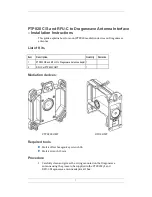
Configuration
QB.11-R Installation and Management
Interface Parameters
77
Satellite Mode
The mandatory parameters to configure for registration of the SU on a Base Station are:
• Network Name
• Base Station System Name (when used)
• Channel Frequency
• Encryption (when used)
• Network Secret
These and other parameters found on the SU’s
Interfaces > Wireless
page are described below.
•
Interface Type:
The interface type is
WORP Satellite
or
WORP Base
.
•
MAC Address:
The factory-assigned MAC address of the unit. This is a read-only field.
•
Base Station System Name:
The name found on the system page of the BSU to which this SU is connecting. This
name is preconfigured on the QuickBridge.11 units and is limited to a length of 30 bytes.
•
Operational Mode:
This field indicates the operational mode of the unit, depending upon the specific Tsunami
QuickBridge unit. This operational mode cannot be changed as it is based upon a license file.
•
Network Name:
A Network Name is a name given to a network so that multiple networks can reuse the same
frequency without problems. An SU can only register to its base if it has the same Network Name. The QuickBridge.11
BSU and SU have a preconfigured Network Name. If you change the Network Name of one unit, you must change the
Network Name of the other unit as well for the two units to communicate. The Network Name is displayed on a sticker
on the unit. The Base Station System Name and Frequency Channel also are parameters to guide the SU to the
proper BSU on the network, but they provide no security. Basic security is provided through encryption, as it causes
none of the messages to be sent in the clear. Further security is provided by mutual authentication of the BSU and SU
using the Network Secret. The Network Name can be 2 to 30 characters in length.
•
Dynamic Data Rate Selection (DDRS) Status:
For the
WORP Satellite Mode
,
DDRS Status
is read-only parameter
and its value is based upon the
WORP Base
to which this SU is associated.
•
Transmit Power Control (TPC):
By default, the unit lets you transmit at the maximum output power for the country or
regulatory domain and frequency selected. However, with Transmit Power Control (TPC), you can adjust the output
power of the unit to a lower level in order to reduce interference to neighboring devices or to use a higher gain
















































